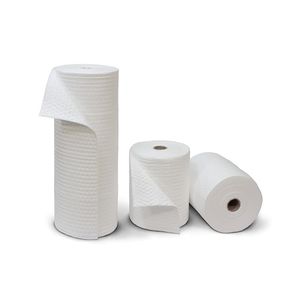
- Products
- Catalogs
- News & Trends
- Exhibitions
Pad absorbent Padex 100 MPoil



Add to favorites
Compare this product
Characteristics
- Type
- pad
- Applications
- oil
Description
Padex 100 MP - low-linting premium oil-only absorbent pads preferentially absorb oil, whilst repelling water. Theywill remove oil from water and are used in internal and external situations, where oil needs to be absorbed without saturating the absorbent with water. Padex 100 MP have a polypropylene core with a fine fiber layer on both sides. This procedure makes the pads extremely low-linting and improves the absorption ability (wicking) and strength of the material. Their perforation makes them easily adjustable for all kinds of applications.
Applications:
Padex 100 MP - low-linting premium oil-only absorbent pads are ideal for use in factories, on lakes, rivers, harbours or at sea and will remain afloat even when saturated with oil.
100% meltblown polypropylene covered with a fine fiber layer on both sides; won't rip, tear or fray even when saturated.
Will absorb up to 25 times its own weight.
Dimple pattern speeds wicking of liquid throughout the material for faster, easier cleanup.
Absorbs and retains oils and oil-based liquids—including lubricants and fuels—without absorbing water
Floats to clean up spills on water.
Bright white color makes absorbed oil easier to see; draws attention to machine leaks and clearly shows saturation level during spill response.
Perforated material is easy to tear to size so you only use what you need.
Low-linting Premium Oil Only Absorbent Pads are ideal for catching drips and soaking up spills
Flame-resistant material won't burn immediately like cellulose; melts when exposed to high heat while on the job.
Non toxic, non reactive and fast acting.
Related Searches
- Rubber matting system
- Vinyl mat
- Absorbent
- Oil absorbent
- Pad absorbent
- Water absorbent
- Exterior mat
- Hydrocarbon absorbent
- Roll absorbent
- Universal absorbent
- Chemical absorbent
- Sock absorbent
- Protection mat
- Powder absorbent
- Polyurethane mat
- Acid absorbent
- Spill containment berm
- Cellulosic absorbent
- Sticky mat
- Pollution control absorbent
*Prices are pre-tax. They exclude delivery charges and customs duties and do not include additional charges for installation or activation options. Prices are indicative only and may vary by country, with changes to the cost of raw materials and exchange rates.


